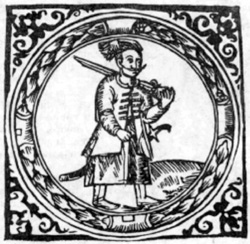Cossacks in Europe

COAT OF ARMS OF THE ZAPORIZHZHIAN HOST
Foreign political contacts of Zaporizhzhian Sich with Western European countries in the sixteenth and seventeenth centuries were basically military by nature. Despite their being subjects of the Polish Crown, the Cossacks often conducted their own independent policy.
In the late sixteenth century, the Cossacks carried out several successful military campaigns in Moldova and Walachia, then protectorates of the Ottoman sultan. The Austrian Habsburgs, then at odds with the Turks, reached an agreement with the Cossacks in 1594, whereby the latter were to raid Moldavia. The campaign was led by Severyn Nalyvaiko who would later lead a Cossack-peasant rebellion against the Poles. A 12,000 Cossack host under his command defeated the Moldavians and their ruler recognized the Habsburg dynasty, for the time being.
In 1618, the Thirty Years’ War broke out in Europe (1618-48) between Austria, Spain, and Bavaria on the one hand, and a bloc of Protestant German princes. At certain stages of the war the Germans received assistance from Denmark, Sweden, Holland, and England. In 1635, Catholic France intervened. Ukrainian Cossack mercenaries took part in the war, switching sides, depending on who hired them. In October 1619, 10,000 volunteers led by Colonels Klychkovsky and Rusynovsky arrived in Zakarpattia, invited by Ferdinand II Habsburg. The empire was in dire straits, with Vienna besieged by Transylvanian Prince Bethlen Gabriel and Czech troops. It was the Cossack campaign in Zakarpattia and Eastern Slovakia, particularly their victory over George I Rakoczy, that made Bethlen Gabriel fold up the siege and rush back to Transylvania.
In 1631, 2000 Cossacks took part in battles with the Swedes and Saxons in Silesia, on the side of Imperial Generalissimo Albrecht Wenzel von Wallenstein. The latter demanded that Polish King Sigismund III supply not Polish hussars, then well-known all over Europe, but Cossacks, whom the Austrian generals used to organize light cavalry units. The French government weekly Gazette de France carried a feature in its 83rd issue of 1631, about a 4,000-strong Ukrainian Cossack cavalry regiment commanded by Tarasky who fought the French in Luxembourg: “The Cossacks attacked the French with a great deal of commotion; our men were not used to such noise, they became afraid and ran...” After France joined the war and its troops invaded the Spanish Netherlands (now Belgium), the Austrian emperor dispatched a large Zaporizhian force which operated in the French rear lines, depleting their forces.
Cossack service abroad was always governed by contract. Thus, under an agreement with the Austrian emperor of September 23, 1635, a Cossack colonel was to be paid 200 thalers and a rank-and-file Cossack 6 thalers a month. The Cossack corps was led by Colonel Pavlo Noskovsky. Throughout 1636, it carried out several blitz raids in Picardy and Alsace. The Austrian emperor did not always honor his commitments under such contracts. This was why Noskovsky’s Cossacks held counsel in 1631, resolving to sever the contract. Long negotiations followed, with the Austrian side pleading and making big promises. Finally, the dispute was solved after the Cossacks were paid part of the debt. But in the fall of 1636, Noskovsky’s Cossacks quit and returned to the Polish kingdom via Silesia.
In the Thirty Years’ War Cossacks also fought on the French side. Future Ukrainian Hetman Bohdan Khmelnytsky (then in the rank of Viyskovy Pysar, literally Military Clerk) met with French Ambassador Count Bregi in Warsaw. The French Ambassador wrote later to Cardinal Mazarin: “The Cossacks are very brave warriors, they are not bad as horsemen and make perfect infantrymen who are especially good when defending a fortress... As for Cossacks serving His Majesty, unless there is a war with the Turks, Khmelnytsky is prepared to assist me in this affair.”
Louis XIV hired 2,400 Ukrainian Cossacks who reached France by sea, through Gdansk and Calais. Many historians maintain that Bohdan Khmelnytsky and Ivan Sirko were Cossack chiefs taking a most active part in the siege and conquest of Dunkerque, then a Spanish fortress. October 11, 1654, the Dunkerque garrison capitulated, but then the French government stopped performing contracts with the Cossacks and part of them returned to Ukraine. There is also sufficient evidence to the effect that Louis XIV used Cossacks in the War of the Devolution (1662-63).
Newspaper output №: Section






